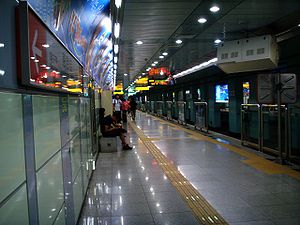Daegu Metro
Daegu Metro (Korean: 대구도시철도; Hanja: 大邱都市鐵道; RR: Daegu dosicheoldo) is a metro system that serves primarily the South Korean city of Daegu.
 | |||
 Jungangno Station | |||
| Overview | |||
|---|---|---|---|
| Owner | City of Daegu | ||
| Locale | Daegu, South Korea | ||
| Transit type | Rapid transit and Monorail | ||
| Number of lines | 2 rapid transit 1 monorail | ||
| Number of stations | 60 (rapid transit only)[1] 90 (incl. monorail) | ||
| Operation | |||
| Began operation | 26 November 1997 | ||
| Operator(s) | Daegu Metropolitan Transit Corporation | ||
| Number of vehicles | Rapid transit train and monorail | ||
| Technical | |||
| System length | 59.8 km (37.2 mi) (rapid transit only)[1] 83.7 km (52.0 mi) (incl. monorail) | ||
| Track gauge | 1,435 mm (4 ft 8 1⁄2 in) (rapid transit only) | ||
| |||
| Daegu Metro | |
| Hangul | |
|---|---|
| Hanja | |
| Revised Romanization | Daegu dosicheoldo |
| McCune–Reischauer | Taegu tosich'ŏlto |

On 28 April 1995, a gas explosion occurred at Line 1, a construction site located in Sangin-dong, Taegu. At least 101 people, including 42 students, were killed with as many as 202 people injured.[2]
Daegu subway fire broke out on 18 February 2003, when an arsonist set fire to a train in rush hour and killed nearly 200 people. Public safety in mass transit became a concern of Korean society.[3]
In December 2008, the Daegu Safety Theme Park opened. The goal is to educate the inhabitants of Daegu about safety in metro.[4]
Lines
| Line Name English |
Line Name Hangul |
Starting Station(s) | Ending Station(s) | Stations | Total Length |
|---|---|---|---|---|---|
| Rapid transit: | |||||
| 1호선 | Seolhwa-Myeonggok | Ansim | 32[1] | 28.4 km[1] | |
| 2호선 | Munyang | Yeungnam Univ. | 29[1] | 31.4 km[1] | |
| Monorail: | |||||
| 3호선 | KNU Medical Center | Yongji | 30 | 23.9 km | |
Line 1
Line 1 was completed in November 1997.
Line 2
Line 2 was completed in October 2005.
Line 3
Line 3, which is a monorail (unlike Lines 1 and 2), was completed and opened in April 2015.
Lines under construction
AGT line
The transport department has approved plans to build an Automated Guideway Transit line. The Color Of AGT line is Purple
Fare
The fare is 1,400 won for a token to any stop on the subway and only 1,250 won with the use of a transportation card.
Rolling stock
Daegu Metro lines are segregated each with its own distinct vehicles. Lines 1 and Line 2 uses the same railway technology (rapid transit) while Line 3 use an entirely different system (monorail).
| Line | Manufacturer (country of origin) | Model | Type | No. car sets ( No. of cars) |
|---|---|---|---|---|
| Line 1 | Hanjin Heavy Industries (Hanjin Transportation) ( |
1000-series | metro cars | 63 (216) |
| Line 2 | Hyundai Rotem ( |
2000-series | metro cars | 30 (180) |
| Line 3 | Hitachi Transportation Systems Korea ( Woojin Industrial System Company Limited ( |
3000-series | straddle-beam monorail | 28 (84)[5] |
See also
- Transport in South Korea
- List of Korea-related topics
- List of metro systems
- List of monorail systems
References
- "Overview > Company Information > Operation System". Daegu Metropolitan Transit Corporation. Archived from the original on 23 September 2015. Retrieved 22 April 2015.
- "어째서 또 이런일이... 大邱 가스폭발 百여명 사망" (Press release). Kyunghyang Shinmun. 29 April 1995. Retrieved 17 August 2015.
- Kirk, Don (27 February 2003). "Subway fire toll rises much higher". International Herald Tribune. Archived from the original on 27 October 2005.
- "Daegu Safety Theme Park (대구시민안전테마파크)". Official Korea Tourism Organization. Retrieved 1 June 2018.
- "Daegu Urban Railway Line 3". Railway Technology. Verdict Media Limited.
External links
- Daegu Metropolitan Subway – official website (in English)
- Daegu at UrbanRail.net (in English)
.png)